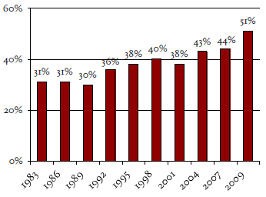
Last summer, New York Life rolled out a new managed account solution that enabled its own agents and brokers to blend investments and insurance in a single portfolio, whose weightings would shift from stocks and life insurance to bonds and annuities over a client’s lifetime.
“We launched it in the agency in the second half of last year. There’s been a lot of excitement around it,” said Michael Gordon, first vice president in New York Life’s U.S. life insurance and agency business, who has led the effort so far. “And we’re seeing sales that are consistent with expectations.”
Now the firm, the world’s largest mutual life insurer, plans to offer that solution to third-party distributors. The first version, called Lifetime Wealth Strategies, is designed for registered reps. A tweaked version, intended for fee-based advisors, is contemplated. The third-party partners haven’t been named yet.
The new platform is significant on several levels. It’s the latest of several insurance industry attempts—not all of them successful—to market retirement income processes instead of just products, in a variation of the old give-them-the-razors-and-sell-them-the-blades strategy. And it’s the first to integrate both life insurance and annuities into investment portfolios.
Lifetime Wealth Strategies also represents major a push by the country’s leading income annuity seller, and one of the healthiest insurance companies in the post-crisis world, to solve the “annuity puzzle” and convince the masses—or at least the mass-affluent—to embrace income annuities.
“Our goal is not to have a 25% of the [SPIA] market,” Gordon said, referring to the fact that, with $1.4 billion in SPIA sales through the first three quarters of 2009, New York Life alone has a quarter of the U.S. SPIA market. “Our goal is to have a smaller share of a much bigger market.”
Partnering with Ibbotson
The financial engineering that drives the program also has a noteworthy pedigree. The underlying formulas, which New York Life calls the “Protection Solution Decision Model,” as well as the client assessment questionnaire, were created through a partnership with Ibbotson Associates, the asset allocation specialty firm owned by Morningstar, Inc.
Guiding Principles of
Lifetime Wealth Strategies |
- The older the individual is, the less life insurance is needed and the more bonds should be included in the asset allocation.
- The higher the initial financial wealth is, the less life insurance is needed but the more bonds should be included in the asset allocation.
- The more risk averse an investor is, the more life insurance is needed and the more bonds should be in the asset allocation.
- The more desire the individual has to make bequests to beneficiaries, the more life insurance is needed, but this bequest desire has little impact on asset allocation.
- The more an individual’s earning power is sensitive to the economy and the stock market, the less life insurance is needed but the more bonds are needed in the asset allocation.
- Including payout annuities in a retirement asset allocation reduces the probability of outliving assets (e.g., reduces longevity risk).
- Fixed-payout annuities substitute for bonds, and variable-payout annuities substitute for stocks, although more aggressive equity mixes can be invested in once longevity risk has been diminished.
- Payout annuities protect against longevity risk; life insurance protects bequests that can be made. In general, the more annuities purchased, the less capital is left over for bequests.
- Payout annuities should generally be purchased after retirement with staggered purchases because annuities are irreversible purchases that partially lock in investors’ asset allocations and reduce bequests.
Source: Ibbotson et al, “Lifetime Financial Advice: Human Capital, Asset Allocation, and Insurance.” The Research Foundation of the CFA Institute, 2007. |
The theory behind it, which includes staggered purchases of income annuities in retirement, can be traced to back as a 2007 monograph, sponsored by the CFA Institute, by Ibbotson’s Roger Ibbotson, Peng Chen and Kevin X. Zhu and York University retirement income expert Moshe Milevsky, called “Lifetime Financial Advice: Human Capital, Asset Allocation and Insurance.”
Laurence B. Siegel, the CFA Institute research director who invited Milevsky and the Ibbotson team to write that monograph, says they answered an important question: “How can people save for retirement in DC world where you have no obvious efficient market in the annuitization part of the solution.”
“You can’t hold the index that you care about most—an index of your consumption,” Siegel told RIJ. “You sort-of can with a laddered portfolio of TIPs, but then you don’t get any mortality pooling. Only an insurance company can do this, and the fact that New York Life is doing it is very reassuring. This really has a chance to change the way money is invested by individuals.”
Aside from designing the platform’s gearbox, Ibbotson is also one of the asset managers. “There are four money managers, one is Morningstar Investment Services, who go for alpha. Then there’s Ibbotson Investment Services. They bring an active/passive hybrid strategy that goes after alpha where alpha is feasible, but will go passive in areas where you can’t beat benchmark,” Gordon said.
“Then there’s Brinker Capital, which overweights to absolute return like an endowment, and Loring Ward, which partners with Dimensional Fund Advisors. They use a passive strategy. They don’t believe in long bonds, and they weight to international equities instead of domestic to offset the short term bonds,” he added.
Peng Chen, president and chief investment officer at Ibbotson Associates, thinks the program will bridge the insurance/investment divide for reps and advisors.
“Most advisors are either equipped to look at asset allocation or insurance, but its trickier to put them together,” he told RIJ. “We have a framework that gives them specific recommendations, and we put the recommendations together in an easily managed cohesive package.
 “We’ve had great traction with this on the agency side. It happens seamlessly and automatically, so that as you get into the retirement stage, you begin to see withdrawals from the life insurance portion to fund the retirement income portion,” he added.
“We’ve had great traction with this on the agency side. It happens seamlessly and automatically, so that as you get into the retirement stage, you begin to see withdrawals from the life insurance portion to fund the retirement income portion,” he added.
The program matches portions of the client’s money with his risks, rather than with specific time-periods. “In the typical ‘bucket methods’ in the market today, you usually see a time-segmented approach,” Chen said. “That doesn’t necessarily solve the issue, however. We’re bucketing not in terms of time segments, but in terms of needs.”
On the account statements, the insurance and investment assets are integrated, with insurance assets counted toward the fixed income allocation of the portfolio. “A conservative investor might be assigned an 88% fixed income and 12% equity allocation, but the fixed income might be part insurance. So the allocation could be 10% insurance, 78% fixed income and 12% equities,” Gordon said.
On a mission
Other insurance companies have launched investment/insurance platforms, with mixed success. Nationwide and Envestnet launched a time-segmented program last summer called RetireSense among Envestnet’s advisors. It’s still too new to assess.
A few years ago, MassMutual introduced a tool called the Retirement Management Account, which came to naught as a result of the financial crisis and internal management conflicts.
Jerry Golden, who created the Retirement Management Account, which employed staggered purchases of income annuities in a rollover IRA, says the New York Life venture is most likely to succeed if it is led by a dedicated, focused marketing team that champions the managed account concept itself, not just the products in it.
If the team is made up of competing advocates of individual products, the whole effort could founder, he said. “If product sales are easier than program sales, then they’ll take the path of least resistance,” said Golden, who left MassMutual after the RMA project imploded.
Before the financial crisis, Phoenix Companies partnered with Lockwood Capital Management on a unified managed account that attached a lifetime income guarantee to an investment portfolio. But New York Life’s platform eschews living benefits in favor of the company’s bread and butter SPIAs, which it calls “Guaranteed Lifetime Income” to avoid the word that continues to confuse and frighten consumers.
The company has steadily nurtured those sales during the first decade of this century.
 In 2003, the company’s SPIA sales were only $115 million. But that year, New York Life’s current CEO, Ted Mathas, called for focus groups to help make the products more consumer-friendly. The company subsequently added liquidity features to the product, such as cash withdrawal opportunities and interest rate adjustments.
In 2003, the company’s SPIA sales were only $115 million. But that year, New York Life’s current CEO, Ted Mathas, called for focus groups to help make the products more consumer-friendly. The company subsequently added liquidity features to the product, such as cash withdrawal opportunities and interest rate adjustments.
Sales rose. In 2004 and 2005, the insurer’s SPIA sales reached $294 million and $439 million, respectively. In 2006, New York Life won the contract to market SPIAs through AARP, and sales grew faster. In the first three-quarters of 2009 alone, New York Life SPIA sales totaled $1.4 billion, including over $600 billion each through captive distribution and third-parties, and $138 million through AARP.
The Lifetime Wealth Strategies program is expected to help maintain the momentum.
“This should massively expand the market,” Gordon said. “It’s like the evolution that the securities industry went through. Buying an individual security was a big deal before mutual funds came along. The process wasn’t scaled yet. You needed Modern Portfolio Theory and asset allocation and then the technological revolution to make it happen. Our idea is that something similar will happen in annuities.”
© 2010 RIJ Publishing. All rights reserved.





 In 2003, the company’s SPIA sales were only $115 million. But that year, New York Life’s current CEO, Ted Mathas, called for focus groups to help make the products more consumer-friendly. The company subsequently added liquidity features to the product, such as cash withdrawal opportunities and interest rate adjustments.
In 2003, the company’s SPIA sales were only $115 million. But that year, New York Life’s current CEO, Ted Mathas, called for focus groups to help make the products more consumer-friendly. The company subsequently added liquidity features to the product, such as cash withdrawal opportunities and interest rate adjustments. 


 Kesmodel believes that, generally, people who have credit card debt or who lack a ‘rainy day fund’ for routine cash crises should probably remedy those issues before worrying about their 401(k) plan, let alone take risks with their investments.
Kesmodel believes that, generally, people who have credit card debt or who lack a ‘rainy day fund’ for routine cash crises should probably remedy those issues before worrying about their 401(k) plan, let alone take risks with their investments.





